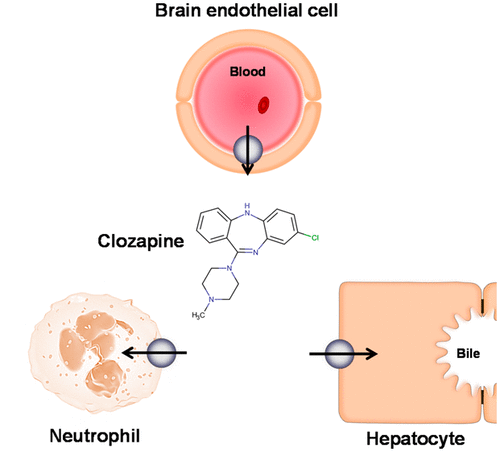当前位置:
X-MOL 学术
›
Mol. Pharmaceutics
›
论文详情
Our official English website, www.x-mol.net, welcomes your feedback! (Note: you will need to create a separate account there.)
Cellular Uptake of the Atypical Antipsychotic Clozapine Is a Carrier-Mediated Process
Molecular Pharmaceutics ( IF 4.9 ) Pub Date : 2018-06-26 00:00:00 , DOI: 10.1021/acs.molpharmaceut.8b00547 David Dickens 1 , Steffen Rädisch 1 , George N. Chiduza 1 , Athina Giannoudis 2 , Michael J. Cross 1 , Hassan Malik 3 , Elke Schaeffeler 4, 5 , Rowena L. Sison-Young 1 , Emma L. Wilkinson 1 , Christopher E. Goldring 1 , Matthias Schwab 4, 6, 7 , Munir Pirmohamed 1 , Anne T. Nies 4, 5
Molecular Pharmaceutics ( IF 4.9 ) Pub Date : 2018-06-26 00:00:00 , DOI: 10.1021/acs.molpharmaceut.8b00547 David Dickens 1 , Steffen Rädisch 1 , George N. Chiduza 1 , Athina Giannoudis 2 , Michael J. Cross 1 , Hassan Malik 3 , Elke Schaeffeler 4, 5 , Rowena L. Sison-Young 1 , Emma L. Wilkinson 1 , Christopher E. Goldring 1 , Matthias Schwab 4, 6, 7 , Munir Pirmohamed 1 , Anne T. Nies 4, 5
Affiliation

|
The weak base antipsychotic clozapine is the most effective medication for treating refractory schizophrenia. The brain-to-plasma concentration of unbound clozapine is greater than unity, indicating transporter-mediated uptake, which has been insufficiently studied. This is important, because it could have a significant impact on clozapine’s efficacy, drug–drug interaction, and safety profile. A major limitation of clozapine’s use is the risk of clozapine-induced agranulocytosis/granulocytopenia (CIAG), which is a rare but severe hematological adverse drug reaction. We first studied the uptake of clozapine into human brain endothelial cells (hCMEC/D3). Clozapine uptake into cells was consistent with a carrier-mediated process, which was time-dependent and saturable (Vmax = 3299 pmol/million cells/min, Km = 35.9 μM). The chemical inhibitors lamotrigine, quetiapine, olanzapine, prazosin, verapamil, indatraline, and chlorpromazine reduced the uptake of clozapine by up to 95%. This could in part explain the in vivo interactions observed in rodents or humans for these compounds. An extensive set of studies utilizing transporter-overexpressing cell lines and siRNA-mediated transporter knockdown in hCMEC/D3 cells showed that clozapine was not a substrate of OCT1 (SLC22A1), OCT3 (SLC22A3), OCTN1 (SLC22A4), OCTN2 (SLC22A5), ENT1 (SLC29A1), ENT2 (SLC29A2), and ENT4/PMAT (SLC29A4). In a recent genome-wide analysis, the hepatic uptake transporters SLCO1B1 (OATP1B1) and SLCO1B3 (OATP1B3) were identified as additional candidate transporters. We therefore also investigated clozapine transport into OATP1B-transfected cells and found that clozapine was neither a substrate nor an inhibitor of OATP1B1 and OATP1B3. In summary, we have identified a carrier-mediated process for clozapine uptake into brain, which may be partly responsible for clozapine’s high unbound accumulation in the brain and its drug–drug interaction profile. Cellular clozapine uptake is independent from currently known drug transporters, and thus, molecular identification of the clozapine transporter will help to understand clozapine’s efficacy and safety profile.
中文翻译:

非典型抗精神病药物氯氮平的细胞摄取是载体介导的过程。
弱碱抗精神病药物氯氮平是治疗难治性精神分裂症的最有效药物。未结合的氯氮平在脑与血浆中的浓度大于1,表明转运蛋白介导的摄取尚未得到充分研究。这很重要,因为它可能对氯氮平的疗效,药物相互作用和安全性产生重大影响。氯氮平使用的主要限制是氯氮平诱发的粒细胞缺乏症/粒细胞减少症(CIAG)的风险,这是一种罕见但严重的血液学不良药物反应。我们首先研究了氯氮平对人脑内皮细胞(hCMEC / D3)的吸收。氯氮平对细胞的吸收与载体介导的过程一致,该过程是时间依赖性且可饱和的(V max= 3299 pmol /百万细胞/分钟,K m= 35.9μM)。化学抑制剂拉莫三嗪,喹硫平,奥氮平,哌唑嗪,维拉帕米,茚达特林和氯丙嗪可使氯氮平的吸收减少多达95%。这可以部分解释在啮齿动物或人类中观察到的这些化合物的体内相互作用。利用hCMEC / D3细胞中过表达转运蛋白的细胞系和siRNA介导的转运蛋白敲低进行的大量研究表明,氯氮平不是OCT1(SLC22A1),OCT3(SLC22A3),OCTN1(SLC22A4),OCTN2(SLC22A5)的底物。 ENT1(SLC29A1),ENT2(SLC29A2)和ENT4 / PMAT(SLC29A4)。在最近的全基因组分析中,肝摄取转运蛋白SLCO1B1(OATP1B1)和SLCO1B3(OATP1B3)被确定为其他候选转运蛋白。因此,我们还研究了氯氮平转运到OATP1B转染的细胞中的过程,发现氯氮平既不是OATP1B1和OATP1B3的底物也不是其抑制剂。总而言之,我们确定了氯氮平进入大脑的一种载体介导的过程,这可能是氯氮平在大脑中的高未结合积累及其药物相互作用的部分原因。细胞对氯氮平的摄取独立于当前已知的药物转运蛋白,因此,氯氮平转运蛋白的分子鉴定将有助于了解氯氮平的功效和安全性。这可能是氯氮平在大脑中的高度未结合积累及其药物相互作用的部分原因。细胞对氯氮平的摄取独立于当前已知的药物转运蛋白,因此,氯氮平转运蛋白的分子鉴定将有助于了解氯氮平的功效和安全性。这可能是氯氮平在大脑中的高度未结合积累及其药物相互作用的部分原因。细胞对氯氮平的摄取独立于当前已知的药物转运蛋白,因此,氯氮平转运蛋白的分子鉴定将有助于了解氯氮平的功效和安全性。
更新日期:2018-06-26
中文翻译:

非典型抗精神病药物氯氮平的细胞摄取是载体介导的过程。
弱碱抗精神病药物氯氮平是治疗难治性精神分裂症的最有效药物。未结合的氯氮平在脑与血浆中的浓度大于1,表明转运蛋白介导的摄取尚未得到充分研究。这很重要,因为它可能对氯氮平的疗效,药物相互作用和安全性产生重大影响。氯氮平使用的主要限制是氯氮平诱发的粒细胞缺乏症/粒细胞减少症(CIAG)的风险,这是一种罕见但严重的血液学不良药物反应。我们首先研究了氯氮平对人脑内皮细胞(hCMEC / D3)的吸收。氯氮平对细胞的吸收与载体介导的过程一致,该过程是时间依赖性且可饱和的(V max= 3299 pmol /百万细胞/分钟,K m= 35.9μM)。化学抑制剂拉莫三嗪,喹硫平,奥氮平,哌唑嗪,维拉帕米,茚达特林和氯丙嗪可使氯氮平的吸收减少多达95%。这可以部分解释在啮齿动物或人类中观察到的这些化合物的体内相互作用。利用hCMEC / D3细胞中过表达转运蛋白的细胞系和siRNA介导的转运蛋白敲低进行的大量研究表明,氯氮平不是OCT1(SLC22A1),OCT3(SLC22A3),OCTN1(SLC22A4),OCTN2(SLC22A5)的底物。 ENT1(SLC29A1),ENT2(SLC29A2)和ENT4 / PMAT(SLC29A4)。在最近的全基因组分析中,肝摄取转运蛋白SLCO1B1(OATP1B1)和SLCO1B3(OATP1B3)被确定为其他候选转运蛋白。因此,我们还研究了氯氮平转运到OATP1B转染的细胞中的过程,发现氯氮平既不是OATP1B1和OATP1B3的底物也不是其抑制剂。总而言之,我们确定了氯氮平进入大脑的一种载体介导的过程,这可能是氯氮平在大脑中的高未结合积累及其药物相互作用的部分原因。细胞对氯氮平的摄取独立于当前已知的药物转运蛋白,因此,氯氮平转运蛋白的分子鉴定将有助于了解氯氮平的功效和安全性。这可能是氯氮平在大脑中的高度未结合积累及其药物相互作用的部分原因。细胞对氯氮平的摄取独立于当前已知的药物转运蛋白,因此,氯氮平转运蛋白的分子鉴定将有助于了解氯氮平的功效和安全性。这可能是氯氮平在大脑中的高度未结合积累及其药物相互作用的部分原因。细胞对氯氮平的摄取独立于当前已知的药物转运蛋白,因此,氯氮平转运蛋白的分子鉴定将有助于了解氯氮平的功效和安全性。


























 京公网安备 11010802027423号
京公网安备 11010802027423号